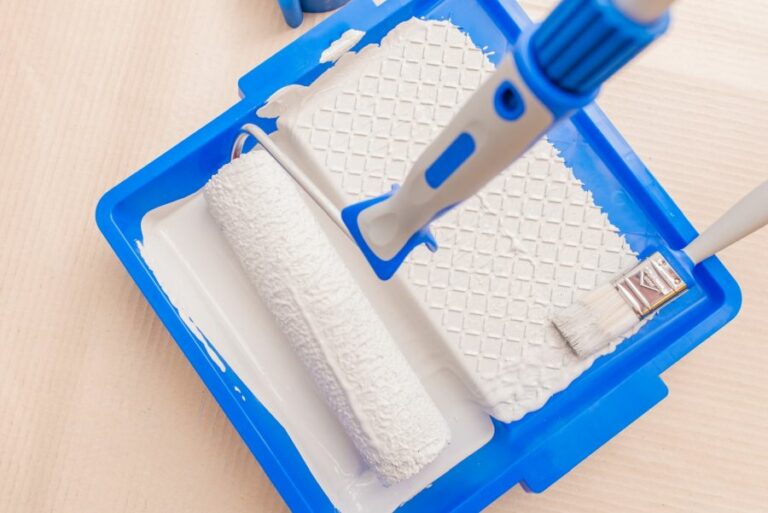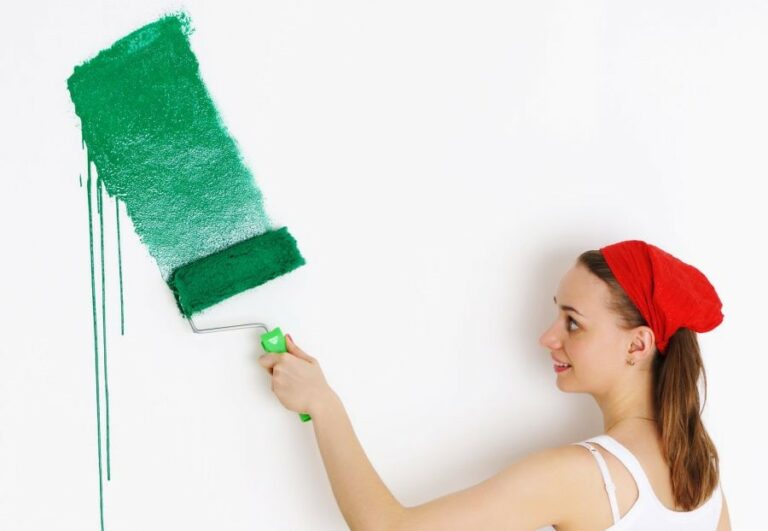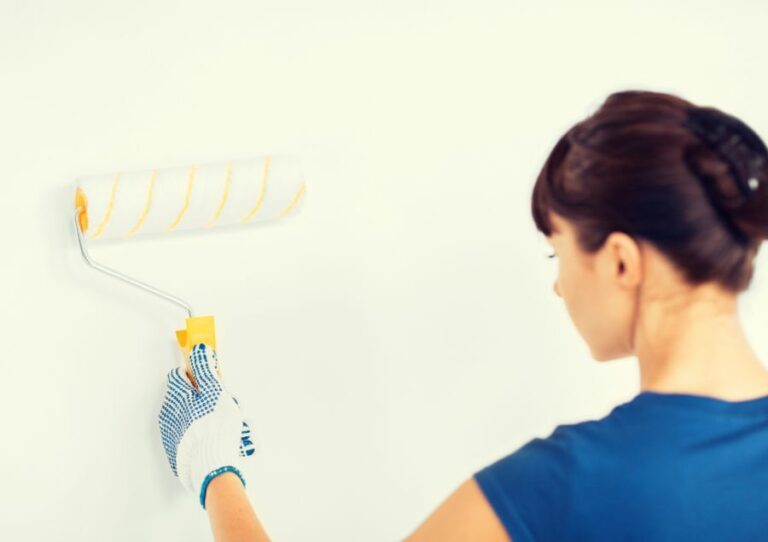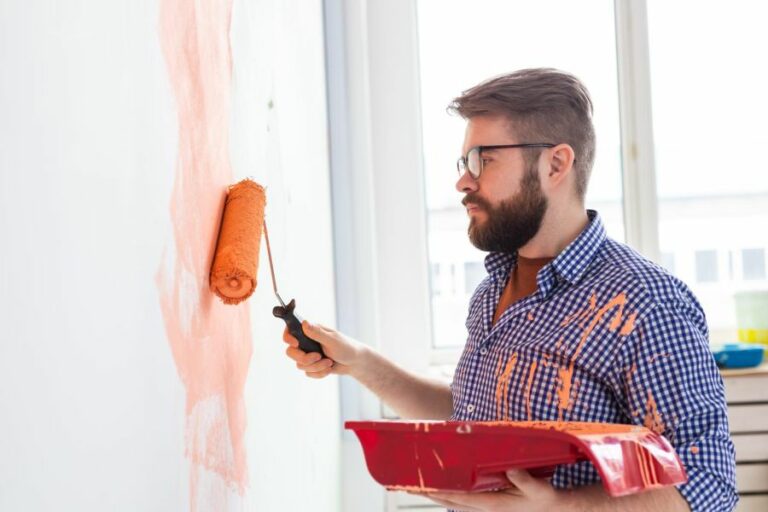Specialty Acrylic Paint For Textured Walls, What Pros Say
Are you tired of trying to find the perfect paint for your textured walls? Look no further! With my expert tips and guidance, you can transform any space into the stunning masterpiece it was always meant to be. So, let’s dive into the world of specialty acrylic paint and make your textured walls look their absolute best.
Specialty acrylic paint for textured walls:
Specialty acrylic paint is a water-based paint specifically formulated for textured surfaces. Its unique properties, such as enhanced adhesion, durability, flexibility, and a wide range of finishes and colors, make it ideal for textured walls. Proper surface preparation, primer application, and using the right tools ensure a smooth, long-lasting finish.

Ready to transform your textured walls with specialty acrylic paint? Discover unique painting techniques, pro tips, and benefits of using acrylic paint specifically designed for textured wall surfaces. Read on to unveil the world of endless creativity and charm!
Contents
- 1 Premium Acrylic Paint for Textured Wall Surfaces
- 2 Top Paint Choices for Enhancing Textured Walls
- 3 Exploring Textured Acrylic Coatings: Features & Benefits
- 4 Tips for Improving the Appearance of Textured Walls
- 5 Discovering Wall Paint with Textured Finishes
Premium Acrylic Paint for Textured Wall Surfaces
• What is Specialty Acrylic Paint?
Specialty acrylic paint is a type of paint specifically formulated for use on textured surfaces. This paint is designed to adhere to rough and uneven surfaces, thanks to its unique properties.
It is water-based and has a high elasticity level, allowing it to contract and expand with the movement of the texture on the walls. This also prevents the paint from cracking or peeling over time.
Specialty acrylic paint is durable, versatile, and available in a range of finishes and colors, making it an excellent choice for textured walls.
• Advantages of Specialty Acrylic Paint
– Enhanced Adhesion
One of the primary benefits of using specialty acrylic paint is its superior adhesion to textured surfaces. Regular acrylic paint may struggle to bond with uneven textures, leading to patchy coverage and poor durability.
Specialty acrylic paint is specifically designed to adhere to these surfaces and ensure a smooth, even finish.
– Durability
Specialty acrylic paint’s unique formula makes it highly resistant to wear and tear. It is less likely to chip or fade, making it an ideal choice for areas with high foot traffic or exposure to harsh environmental conditions.
– Flexibility
The high elasticity of specialty acrylic paint enables it to contract and expand with the surface it is applied to. This feature allows the paint to maintain its bond with the wall, resisting cracks and peeling even with the movement of the textured surface.
– Easy Application
Applying specialty acrylic paint is a straightforward process, as it can be applied to textured surfaces using brushes, rollers, or even airless sprayers. Its water-based nature also makes clean-up a breeze.
– Wide Range of Finishes and Colors
Specialty acrylic paint is available in a variety of finishes, from flat and satin to semi-gloss and gloss, allowing you to achieve the desired look for your walls. Moreover, it comes in a broad spectrum of colors, giving you endless options for personalizing your space.
• Tips for Applying Specialty Acrylic Paint to Textured Walls
– Surface Preparation
As with any painting project, proper surface preparation is essential for successful application and long-lasting results:
- Clean the walls thoroughly, removing any dirt, dust, or debris.
- Repair any cracks or holes with appropriate filler material and allow it to dry.
- Sand the surface lightly to ensure even paint adhesion.
– Primer Application
It is recommended to apply a high-quality primer before painting textured walls. A primer will enhance the paint’s adhesion, reduce the number of coats required, and provide a more uniform appearance.
– Choosing the Right Tools
Selecting the right tools for your painting project is crucial for achieving the desired results:
- Brushes: Choose a high-quality, synthetic bristle brush suited for acrylic paint. A brush with angled bristles can help in reaching the edges and corners of textured walls.
- Rollers: Opt for a roller with a thick nap (3/4-inch or more) to ensure the paint penetrates the deep areas of the texture.
- Airless Sprayer: If you prefer using a paint sprayer, an airless model with a low-pressure setting is recommended for applying specialty acrylic paint. Practice on a sample surface before spraying your walls to achieve the appropriate coverage and texture.
– Painting Technique
When applying specialty acrylic paint, use the following techniques to achieve the best results:
- Work in small sections, applying the paint in a “W” pattern.
- Use a light, even pressure to avoid overloading the texture and maintain its effectiveness.
- Allow the paint to dry according to the manufacturer’s instructions before applying additional coats.
• Conclusion
Specialty acrylic paint is an ideal choice for textured walls due to its unique characteristics, like enhanced adhesion, durability, flexibility, and ease of application. With the proper tools, techniques, and surface preparation, you can achieve stunning, long-lasting results.
For additional painting resources and guides, consider visiting the Paint Quality Institute website, which offers valuable tips and insights on various paint-related topics.
Top Paint Choices for Enhancing Textured Walls
If you have textured walls in your home, it can be a challenge to find the right paint that both enhances the texture and provides long-lasting coverage.
• Understanding Textured Walls
Textured walls have a unique aesthetic that can significantly impact the overall feel of a room. Whether it’s intentional as a design choice or to conceal imperfections and damage, knowing the proper techniques and materials to use is crucial for achieving an attractive finish.
When it comes to painting these surfaces, the right paint choice is essential, as certain types may work better or worse with particular textures.
• Types of Texture
First and foremost, it’s important to understand the various types of textures that may exist on your walls. Some common ones include:
- Knockdown
- Orange peel
- Popcorn
- Swirl
Each of these textures requires specific paint materials and application methods to achieve a successful finish, so identifying the type in your space will help guide you in the right direction.
• Water-Based vs. Oil-Based Paints
One of the first considerations when selecting paint for textured walls is to determine whether you should use water-based (latex) or oil-based (alkyd) paint.
– Water-Based (Latex) Paints
Latex paints are the most popular choice for residential painting projects due to their ease of use, fast drying time, and environmental friendliness. They offer great adhesion and flexibility and are generally resistant to mildew and moisture.
For textured walls, latex paint is highly recommended since it won’t harden or crack over the texture like oil-based paint might. There are some specific qualities to look for that will make it even more effective for textured surfaces:
- High-Quality Acrylic: Acrylic latex paints often have better adhesion and durability than other types of latex paints, making them suitable for textured walls. Higher-quality acrylic paint will provide better coverage and maintain the integrity of the texture.
- Thicker Consistency: Paint that is too thin can easily run and cause streaks on textured surfaces, so look for a thicker paint that will cling to the peaks and valleys of the texture without dripping.
- Higher Sheen: Flat or matte paints tend to show imperfections more easily, while higher-sheen options like eggshell, satin, or semi-gloss can minimize the appearance of irregularities and offer a smoother finish. However, opting for a sheen that is too glossy might emphasize the texture, so finding the right balance is essential.
– Oil-Based (Alkyd) Paints
Oil-based paints are known for their durability and ability to adhere to a wide variety of surfaces, making them a solid choice in certain circumstances.
However, they’re generally less favored for interior residential spaces since they emit high levels of volatile organic compounds (VOCs), have a longer drying time, and require chemicals like turpentine or mineral spirits for clean-up.
Given the inherent properties of oil-based paints and their potential for cracking on textured surfaces, they are typically not recommended for painting textured walls.
• Primer: A Key Component
Before painting your textured walls, applying a primer can be a game-changer. Primers help seal the surface, ensuring better paint adhesion and a more even finish. High-quality acrylic primers are ideal for textured walls, as they provide the necessary flexibility to prevent cracking and peeling.
• Application Techniques and Tools
Proper application is vital when painting textured walls. Here are some tips and recommended tools to ensure a successful outcome:
– Rollers
For a textured wall, using the right roller is crucial. Choose a roller with a thicker nap (often ranging from 3/4 to 1 inch) that can accommodate the texture and adequately reach the crevices.
– Brushes
For cutting in and painting around fixtures, choose a high-quality brush with a chiseled edge, which aids in achieving precise lines on textured surfaces.
– Applying Paint
When applying paint to textured walls, work in small sections, and use a zigzag pattern to avoid leaving harsh edges or seams. Then use a smoother, overlapping rolling motion to eliminate lines or ridges left by the roller. Applying multiple thin coats will yield a more uniform and durable finish than a single thick coat.
• Final Words of Advice
In conclusion, choosing the best paint for textured walls greatly depends on understanding the type of texture and selecting a high-quality acrylic latex paint that is compatible.
Additionally, using the proper tools and application techniques will ensure a lasting and professional finish. For further information and guidance, check out resources from credible sources like This Old House, which offers expert advice and tutorials on painting textured walls.
Exploring Textured Acrylic Coatings: Features & Benefits
The textured acrylic coating is a versatile and durable protective coating that can be applied to various surfaces both indoors and outdoors.
It is widely popular due to its ability to provide a textured finish that adds visual appeal and depth to surfaces while also offering excellent resistance to various weather elements, dirt, and mildew.
• Acrylic Resins: The Base of Textured Acrylic Coating
The textured acrylic coating is made from acrylic resins, which are synthetic polymers that offer excellent adhesion, flexibility, and resistance to UV rays and environmental pollutants. These resins are water-based, making them environmentally friendly and easy to clean with soap and water.
When combined with various texturing agents, acrylic resins create textured coatings that can mimic the appearance of stucco, plaster, sandstone, and other textured materials. This versatility makes textured acrylic coatings a popular option for many different applications.
• Benefits of Textured Acrylic Coating
There are several advantages to choosing textured acrylic coatings for your surface treatment needs:
– Durability
This type of coating is highly resistant to cracking, peeling, and chipping, making it an ideal choice for long-term protection of your surfaces. Due to its inherent flexibility, it can easily expand and contract with temperature changes, reducing the likelihood of damage over time.
– Weather Resistance
Textured acrylic coatings offer excellent resistance to UV rays, rain, and humidity, making them a suitable option for outdoor surfaces. These coatings can withstand harsh environmental conditions without compromising their appearance or performance.
– Low Maintenance
The textured finish of this coating is not only visually appealing but also serves as a practical feature. The grooves and ridges can help conceal dirt and grime, while the coating’s resistance to mildew and algae growth means it requires less frequent cleaning.
– Aesthetic Appeal
One of the primary reasons people choose textured acrylic coatings is for their aesthetic appeal. These coatings can mimic the look of various textured materials, allowing you to enhance the appearance of your surfaces without the need for costly or time-consuming traditional texturing methods.
• Applications of Textured Acrylic Coating
There are numerous applications for textured acrylic coatings, including:
- Exterior wall surfaces, such as stucco, masonry, and concrete
- Interior wall surfaces, including drywall, plaster, and textured wallpaper
- Architectural features, like columns, archways, and trim
- Decks, patios, and pool surrounds
- Furniture and decorative items
• Choosing the Right Textured Acrylic Coating
Before selecting a textured acrylic coating, there are a few factors to consider:
- Intended Application: Consider whether the coating will be used indoors or outdoors, as well as the type of surface to which it will be applied. This will influence your choice of product and the necessary surface preparation steps.
- Desired Texture: Textured acrylic coatings come in many different textures and finishes. Be sure to select a product that provides the desired appearance for your specific project.
- Color: These coatings are typically available in a wide range of colors, allowing users to find the perfect match for their design needs. Keep in mind that some brands may offer more color options than others.
- VOC Content: Volatile organic compounds (VOCs) are emitted as gases from certain chemicals, including paint products. Consider choosing coatings with low or no VOCs to minimize your environmental impact and maintain healthy indoor air quality.
- Product Reviews and Recommendations: Finally, it’s essential to read product reviews and consider recommendations from industry professionals or others who have experience with the specific product you’re considering.
• Application Process for Textured Acrylic Coating
The process for applying textured acrylic coatings varies depending on the specific product and surface being coated. Generally, the steps include:
- Surface Preparation: Remove dirt, grease, and any loose or peeling paint from the surface. Patch any cracks or holes and sand if necessary. Ensure the surface is clean and dry before proceeding.
- Priming: Apply a suitable primer, if required, according to the product instructions. Allow the primer to dry completely.
- Application: Use the appropriate tools, such as a paint roller, brush, or spray applicator, to apply the textured acrylic coating. Some coatings may require more than one coat. Be sure to follow the manufacturer’s guidelines on application techniques, drying times, and recommended coverage rates.
- Sealing: Once the textured acrylic coating is dry, you may need to apply a sealer to protect the surface further and enhance the coating’s durability.
In conclusion, textured acrylic coatings offer a durable and aesthetically pleasing solution for various surfaces, both indoors and outdoors. By considering factors such as intended application, desired texture, and color, you can choose the best product for your specific needs.
Following the proper surface preparation and application techniques is essential to ensure a long-lasting, beautiful finish.
Tips for Improving the Appearance of Textured Walls
Textured walls have a charm of their own, adding dimension and character to a room. However, they can also appear dated and dull if not properly maintained or decorated.
If you want to improve the look of your textured walls without going through the hassle of completely redoing them, here are some expert tips to follow.
• 1. Clean and Repair the Walls
Before starting any cosmetic improvements, it is essential first to clean and repair the walls. Textured walls can easily gather dust, dirt, and cobwebs. Use a soft broom or a vacuum cleaner with a brush attachment to remove any dirt accumulated on the surface.
You can also use a damp cloth or sponge to gently clean the walls without damaging the texture. For more thorough guidance on cleaning textured walls, refer to this article by the University of Missouri.
Inspect the walls for any damages or inconsistencies in the texture. Small cracks or peeling areas can be fixed with a quick patch-up using a pre-mixed joint compound or textured wall repair product.
Apply the joint compound to the damaged area with a putty knife, ensuring that it blends seamlessly with the existing texture. Allow it to dry, and sand it lightly if needed.
• 2. Paint the Textured Walls
A fresh coat of paint can work wonders in enhancing the look of your textured walls. Choose a color that complements the overall aesthetic of your room. Lighter colors tend to make the room feel more spacious, while darker shades can add coziness and depth.
It is essential to use the right type of paint and tools when painting textured walls. High-quality latex paint with an eggshell or satin finish is often recommended for textured walls due to its durability and ease of cleaning.
Investing in a high-quality paintbrush or roller designed for textured surfaces helps in achieving an even paint application without leaving marks or streaks.
When painting, make sure to apply multiple thin coats rather than one thick coat to avoid an uneven texture. This ensures that the final result looks smooth and professional.
• 3. Incorporate Wall Accessories
Wall accessories can significantly improve the overall look of your textured walls while also adding a personal touch to space. For instance, hanging mirrors on your textured walls can create an illusion of more space and light, making a room feel more open and spacious.
Consider adding artwork, framed photographs, or decorative signs to the walls. If you have a specific theme or color scheme in your room, select pieces that complement it. Be careful not to overcrowd the space with too many wall accessories, as this can make the room feel cluttered.
• 4. Use Lighting to Enhance the Texture
Strategic lighting can emphasize the unique texture of your walls and create a focal point in the room. For instance, installing wall sconces, uplights, or downlights can cast dramatic shadows on the wall’s surface, drawing attention to the texture and adding visual interest.
Choose lighting fixtures that echo the style and color scheme of the room. Ensure that they are installed at the correct height and angle to produce the desired effect on the textured wall.
• 5. Combine with Smooth Elements
To create a balanced and visually appealing space, consider combining your textured walls with smooth surfaces and clean lines. For instance, installing sleek and modern furniture, such as a sectional sofa or a minimalist bookcase, can help create harmony between the textured walls and the rest of the room.
In addition, consider incorporating textiles like smooth curtains or throw pillows to soften the overall appearance of the space and create an inviting atmosphere.
• In Conclusion
Improving the look of textured walls does not always involve a costly or time-consuming renovation process. By following these expert tips, you can enhance their appearance and create a space that is both stylish and comfortable.
Remember to clean and repair your walls, choose the right paint and tools, add wall accessories and lighting, and combine with smooth elements to achieve a beautiful and balanced design.
Discovering Wall Paint with Textured Finishes
Textured paint has gained popularity in recent years as a versatile and durable option to add some depth and character to any room. Used by professional decorators and DIY enthusiasts alike, this special type of paint can create a textured surface that not only looks great but also hides imperfections on walls.
• Types of Textured Paint
There are several types of textured paint available, each with its own unique characteristics and suitable applications:
– Pre-Mixed Texture Paint
Ready-made textured paint is available, which already contains the components required to create a particular texture. This type of paint comes in a variety of pre-defined textures, such as popcorn, sand, and stone.
It is usually applied using a regular paint roller or brush and does not require any specialized tools or skills.
– Additives for Textured Paint
Another option is to purchase additives that can be mixed with regular paint to create textured finishes. These additives are available in various forms, such as fine sand, pumice, and even glass beads.
The right choice of additive will depend on the desired texture, so it is essential to research and test each additive to find the best fit for your project.
– Thickening Agents
In addition to ready-made textured paint and additives, thickening agents can be added to latex or acrylic paint to increase its viscosity. This allows you to manipulate the paint’s surface once easily applied to create ridges, peaks, and patterns. Common thickening agents include joint compound and craft glue.
• Techniques for Applying Textured Paint
Textured paint can be applied using various techniques, depending on the desired final effect. Some common application methods include:
– Stippling
Stippling involves using a stiff-bristled brush or stippling brush to dab the textured paint onto the wall. This technique creates a dappled effect with small peaks and valleys.
– Rolling
Applying textured paint with a paint roller is a quick and efficient way to cover larger surface areas. Depending on the type of roller cover used, different textures can be achieved.
– Trowelling
This technique uses a trowel to spread textured paint across the surface of the wall, creating various patterns and effects. Trowelling is a popular choice for creating more substantial textures such as stucco or plaster finishes.
– Spraying
For consistent and professional-looking results, a high-pressure paint sprayer can be used to apply textured paint or additives. This method requires some experience, and proper protective equipment should always be worn.
• Benefits of Textured Paint for Walls
Using textured paint on your walls has several advantages:
– Aesthetic Appeal
Textured paint adds character and depth to a room, allowing you to create accent walls or introduce new patterns and finishes that can diversify the overall look and feel.
– Imperfections Concealment
One of the key advantages of textured paint is its ability to hide surface imperfections, such as cracks, nail holes, or uneven patches. Textured finishes can cleverly disguise flaws, which makes them an excellent choice for older walls or surfaces that have been subjected to wear and tear.
– Acoustic Properties
Textured paint on walls can help dampen sound, making rooms quieter and more comfortable with reduced echoing.
– Durability
As textured paint is generally thicker than standard paint, it provides a tougher and more durable finish for your walls. This makes it resistant to knocks, scratches, and general wear and tear.
• Tips for Success with Textured Paint
From my experience, here are a few tips for working with textured paint effectively:
- Testing: Before committing to a specific surface and paint, experiment with different types of textured paint and application techniques to ensure you’re happy with the final result.
- Preparation: Ensure the surfaces are clean, dry, and free of loose or peeling paint. Any cracks or holes should be filled before painting.
- Protection: As with any paint job, make sure to protect your floors and furniture by laying down plastic sheets or drop cloths.
- Patience: Textured paint can take longer to dry than regular paint, so resist the urge to touch or overwork the surface.
Textured paint offers endless possibilities to transform and enhance the walls of your home or workspace. With a wide range of products available and various techniques to choose from, you’ll be able to find the perfect textured finish to suit your style and needs.







